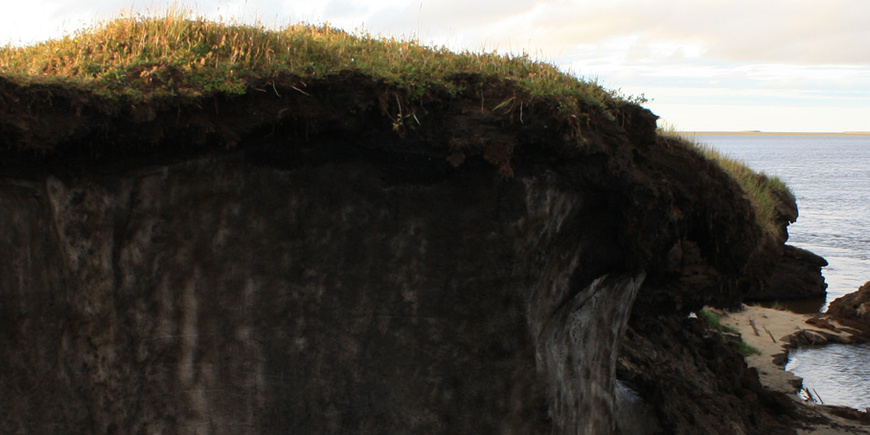30.07.2015: Thawing submarine permafrost is not the source of high methane (CH4) concentrations in sea water off the arctic Russian coast. The current issue of the scientific journal Nature Climate Change discusses recent findings of a team of scientists, including GFZ-staff, showing that microbial activity at the thaw front prevents the release of methane into the water column.
A team of scientists from Alfred Wegener Institute for Polar and Marine Research (AWI), GFZ, University of Hamburg, and Mel’nikov Permafrost Institute Yakutsk in Russia investigated a sediment core from a water depth of 4 meter sfrom the continental shelf in the central Laptev Sea. Biogeochemical analysis for the first time reveal that methane released from thawing permafrost is consumed by microbes before it could enter the overlying sediment. Thereby the oxidation of methane is effectively preventing its release into the water column.
The involved scientist Prof. Susanne Liebner, GFZ section Geomicrobiology, states: “Our results only represent a single part of the vast area of submarine arctic permafrost. However, if these results can be extrapolated across the arctic region, thawing submarine permafrost can be excluded as the source for high methane concentrations in Siberian coastal waters.” The real source will still have to be identified, a potential candidate is deeper lying marine gas sources.
Thawing arctic permafrost is regarded as an important source of the highly effective greenhouse gas methane and therewith as a contributor to global warming. After the end of the last glaciation rising sea level inundated vast areas of the permafrost that today lie below sea level. This thawing submarine permafrost was previously considered as the source for high methane gas concentrations in the waters off the Siberian coast of Russia.








![[Translate to English:] Torsten Sachs in front of a climate station on a field](/fileadmin/_processed_/3/9/csm__TorstenSachs_bearbeitet_GS_4a1365ef84.jpeg)

![[Translate to English:] left image flood at the Ahrtal: image from above, several houses are flooded; left image:: Heidi Kreibich;](/fileadmin/_processed_/4/4/csm_Bild2_9af0130e9f.png)



![[Translate to English:] Start der Vega Rakete](/fileadmin/_processed_/6/4/csm_20231201-kachel_Vega-VV23-launch_ESA-CNES-Arianespace_706716b68c.jpeg)









![[Translate to English:] Poster exhibition at the Brandenburg Hydrogen Day at the GFZ, some participants in the foreground](/fileadmin/_processed_/6/5/csm_Erster_Brandenburgischer_Wasserstofftag_GFZ_402fcec95e.jpeg)
![[Translate to English:] Group picture of the participants](/fileadmin/_processed_/9/4/csm_20231108_CAWa-Workshop-Tashkent_Gruppenbild_99ea779d8a.jpeg)

![[Translate to English:] [Translate to English:] Hörsaal](/fileadmin/_processed_/e/6/csm_H%C3%B6rsal_e21ac645fb.jpeg)


![[Translate to English:] The Delegations in the Historic Library on the Telegrafenberg. In the back there are from left to right, the Dutch Ambassador for Germany, Ronald van Roeden, the Dutch Minister for Education, Culture and Science, Robbert Dijkgraaf and the scientific director of the GFZ, Susanne Buiter.](/fileadmin/_processed_/d/b/csm_Kachel-2_9eba4b4212.jpeg)

